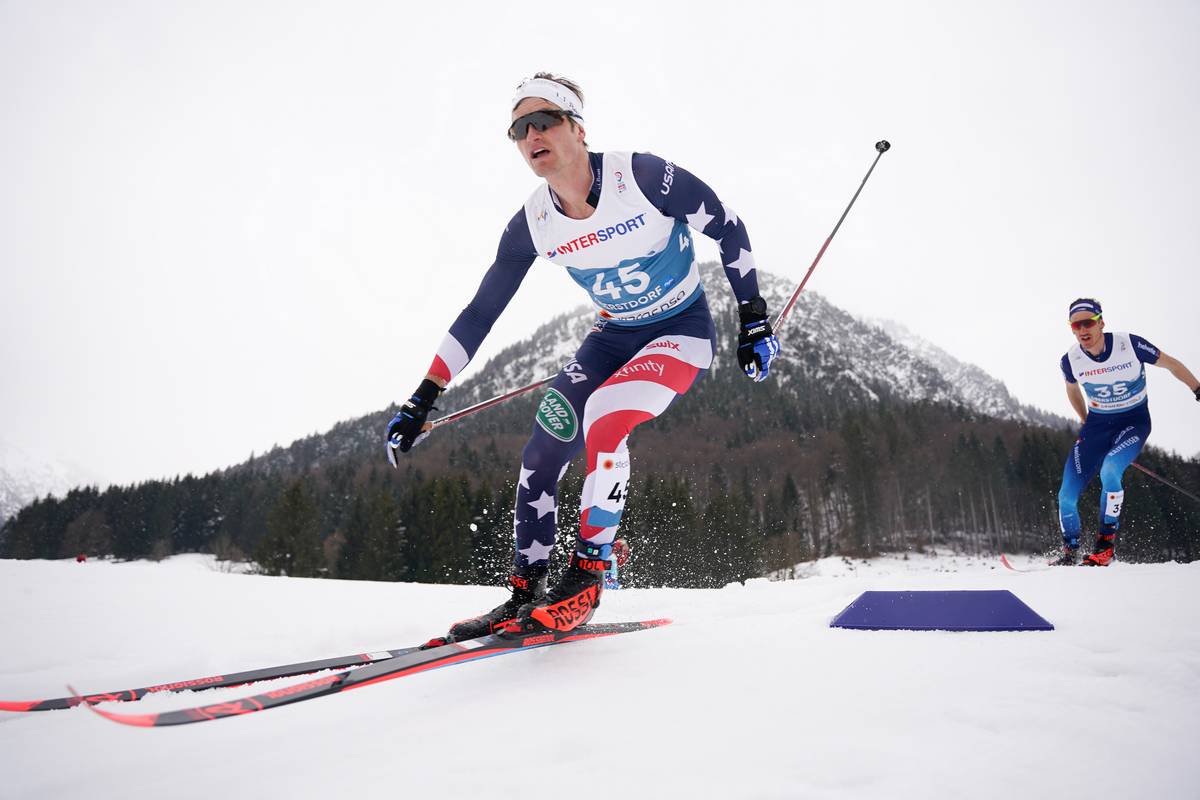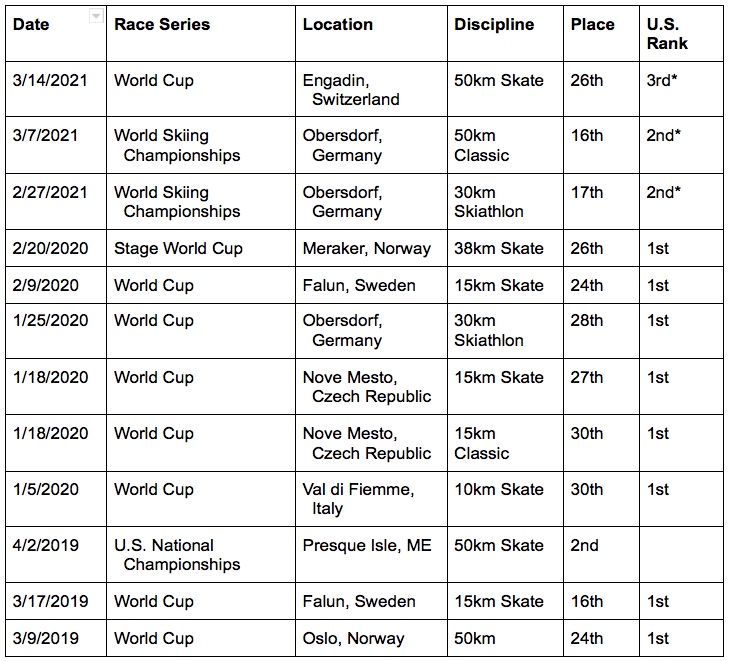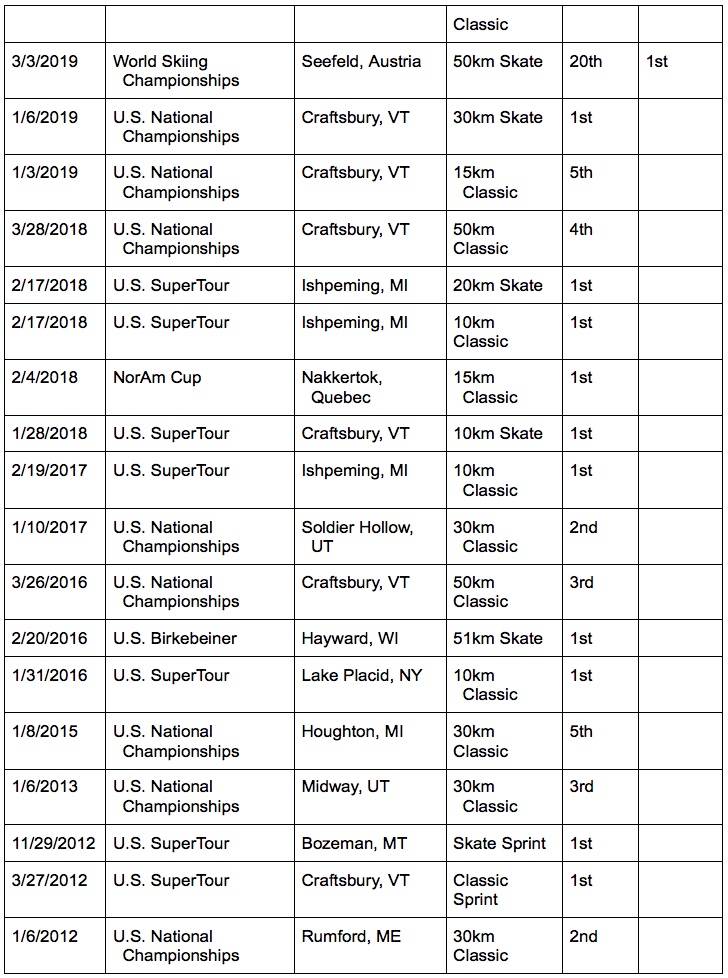
I have been racing against David Norris for the past 10 years. We have battled head to head trying to crush each other. The end game was to earn valuable points on the domestic SuperTour circuit to qualify for World Cups. There have been many times we have swapped podium places at U.S. National Championships and U.S. SuperTours. As a one-time peer of David’s, I understand the need for funding and support to compete effectively at the elite level. I am trying to spread awareness and cultivate support among the U.S. cross-country ski community to persuade the U.S. Ski Team that David deserves to be a member for 2021-2022. He needs the support and expertise of the national team to realize the next step in his progression.
The team looks incredibly strong. With the clear trend of capturing young and accomplished skiers, the 2021-2022 U.S. team is full of potential. However, many athletes and coaches were surprised when the U.S. Ski Team announcement recently dropped. The team roster lacked a key athlete: David Norris. David has been one of the most consistent and top-performing distance skiers in the United States since 2010. There is data to prove this claim and you can see the results spreadsheet I’ve organized at the end of this piece.
I know this is a merciless pursuit. As does David. Let’s get this point out of the way – David is thirty years old. As the U.S. Team’s objective criteria trends, Norris has many tree rings. There’s also this undeniable truth, in addition to his strong domestic consistency, David has been improving on the World Cup since his debut in 2017. He has achieved an astounding 12 top-30 individual World Cup results. In 75% of those races, he ranked as the best U.S. male finisher. In his first FIS World Skiing Championships in Seefeld, Austria in 2019 David placed 20th in the 50km skate; again, crossing the line as the first U.S. athlete. In his second FIS World Skiing Championships in Oberstdorf, Germany in 2021 David placed 17th in the 30km skiathlon and 16th in the 50km classic. With these two recent top-20s, he crossed the line as the second U.S. athlete in both races behind Scott Patterson.
This is a small sample size, two World Champs. But trends are trends. In Seefeld, he posted a 20th in the 50 k skate. Two years later he improved four places to 16th in the 50 k classic. That’s a 20% improvement in place. It also demonstrates David’s all-around capacity in the dual techniques. It’s the same in the skiathlon — a bump from 36th in Seefeld to 17th in Oberstdorf can only be spun one way: promise, potential, and the ability on a special day to nail a top-10 or better.
It would seem clear to any outsider or cross-country ski enthusiast that an athlete consistently achieving top-20 results in World Championships and is the first or second U.S. athlete deserves a spot on the U.S. Ski Team. This puzzles many athletes, coaches, and fans. David did miss the team’s objective criteria. But, what adds to the confusion is that seven of the 21 U.S. Ski Team nominations this year were used with discretion, meaning they did not meet the objective criteria. Why would discretion not be used for the case of David Norris?
I am aware that no criteria will ever be “perfect” and there will always be arguments and disagreements for every criteria and selection qualification process. There’s always at least one skier on the wrong side of the equation. I think the U.S. Ski Team selection is strong for 2022. I do have a serious concern, however, and I think we should be asking the question, why are such great criteria missing one of our best athletes?
There is a clause in the 2022 U.S. Cross Country Team Nomination Criteria under the Discretionary Selection Policy: “… the staff may consider any factors including… Illness or injury during the selection period.”
It is crucial to know and publicize that David Norris suffered from Covid-19 during the fall of 2020. This may come as a surprise to many readers because David is not one to be dramatic or complain about any factors that negatively affect his performance or racing. He quietly recovered and worked into his training as his body allowed. He still went on to earn two top-20 World Championship finishes.
To be blunt, he is lucky to be alive. And the fact that he was able to achieve such outstanding results is embarrassingly overlooked and underappreciated. Elite cross-country ski racers have to be extremely cautious of the common cold or the flu, but to take on one of the most severe respiratory diseases in a century should be covered by “illness or injury during the selection period.”
Due to Covid, David missed his fall World Cup starts. He lost valuable points and arguably the most important part of the season for hard-effort training and obtaining race fitness. He lost chances for more potential top-30 finishes and FIS points, thereby effectively erasing any opportunity to objectively qualify for the U.S. Ski Team. This is exactly what the discretionary clause was designed for: to give an opportunity to athletes who have been affected by factors well outside of their control, yet who still show talent and drive and results to be recognized by the U.S. Ski Team.
So then we have the question again: why was he not selected for the U.S. Ski Team?
Age comes into the equation as many have noticed. The U.S. Ski Team is developing an impressively talented and young team. While this will play a key role in improving our results as a nation in years to come, we cannot lose sight of the talent and abilities of some current older athletes. David is not an athlete knocking on the doors of top-30 World Cups. He is not the 4th or 5th U.S. skier at World Cups. Two other U.S. distance skiers can do what he does. Both skiers were nominated for the 2022 U.S. Ski Team (Gus and Scott).
Qualifying for World Cups as a non-team member and racing as a member of the U.S. Ski Team are starkly different experiences. David has proven that he can compete against the best in the world, and the best distance skiers from the U.S. while being self-supported and coordinating his own wax technicians. (As a non-team member on the World Cup, the responsibility for funding a wax tech falls to David.)
As background actors, wax technicians are chronically overlooked, but I think they are as important as the athlete to earning strong World Cup results. Having a consistent wax technician who knows the athlete, the ski fleet, European race conditions, grinds, flexes, cambers, and wax is more important than the average viewer realizes. The relationship and knowledge of a wax technician to their athletes’ skis can make or break races. I think we as a country are all curious and excited to see the day that David is a fully supported U.S. Ski Team athlete with a consistent wax technician and without the burden of coordinating sponsorships, funding, and his wax tech needs for upcoming World Cup races. Last season Norris employed four different wax techs between the end of January and mid-March.
There’s only an upside to Norris’ potential. Imagine his potential if he were fully funded with access to the full arsenal of national team resources.
As a fellow distance skier, I can attest to the challenge of going from winning U.S. SuperTour races to trying to crack a top-30 on the World Cup. It is not an easy task. I feel like I came from a sort of “middle generation” of U.S. distance skiers between the legendary Noah Hoffman, Kris Freeman, and Erik Bjornsen and the new guns like GU.S. Schumacher, Luke Jager, Ben Odgen, and Johnny Hagenbuch just to name a few. I count myself proud and lucky to have raced with such talented distance skiers like Kyle Bratrud, Adam Martin, Ian Torchia, Paddy Caldwell, Scott Patterson, David Norris, among many others, all of whom were on and off the World Cup circuit. I obtained the SuperTour leader position for at least one period per year for four years in a row from 2016-2020.
I had ample opportunities to prove myself worthy of the U.S. Ski Team. I raced 32 World Cups and two World Championship starts. I was one of many U.S. distance skiers who dreamed of cracking that top-30, earning World Cup points, and making the U.S. Ski Team. It was incredibly hard for all of us to make that break. I cannot stress enough the increase in difficulty for U.S. men from winning a U.S. National Championship or SuperTour to popping a top-30 individual World Cup result. Only two of our generation were able to consistently make that break into the top-30: Scott Patterson and David Norris. Scott was selected to the U.S. Ski Team. David deserves it as well. I know they both belong in Europe representing the U.S. because they are the best we have.
I do not feel that the United States has the luxury to not name David Norris to the U.S. Ski Team. We are a small and tightly knit community in a country that does not appreciate nor endorse cross-country skiing as a national sport. It is imperative to support our best skiers especially on the men’s team, not only for achieving top results at the 2022 Winter Olympics but also to develop and establish a strong team for the future.
Helping keep David in the game benefits a generation of younger skiers. They learn that when you are one of the top three distance skiers in the country, a top-20 skier at World Championships, the national team has your back.
The current scenario is a bit of déjà vu for Norris. Last season he missed meeting the team’s objective criteria by 0.88 points. He was not discrentioned to the team for 2021.
If you would like to learn more about David Norris and his situation, please visit this link to a petition: https://www.change.org/p/U.S.-ski-and-snowboard-nominate-david-norris-to-U.S.-ski-team-2021-2022
Appendix I: David Norris’ Top Results Since 2010.
I limited these results to 1st place at U.S. SuperTours, top 5 results at U.S. National Championships, and top 30 at the World Cup or World Championships.
(Results pulled from https://www.fis-ski.com/)
*Results after recovering from Covid-19.
Ben Lustgarten
Ben Lustgarten was born and raised in Burlington, Vermont and began ski racing in high school. He raced professionally for six years, the last four with the Craftsbury Green Racing Project. He won a 2017 U.S. National Championship, and represented the the U.S. on the World Cup from 2017-2020.






